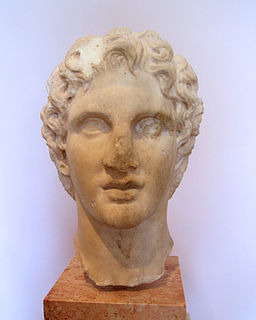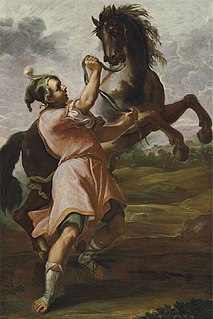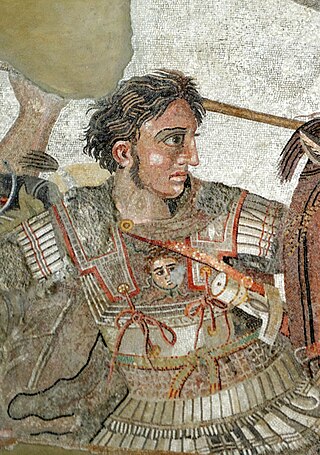
Alexander III of Macedon, commonly known as Alexander the Great, was a king of the ancient Greek kingdom of Macedon. He succeeded his father Philip II to the throne in 336 BC at the age of 20, and spent most of his ruling years conducting a lengthy military campaign throughout Western Asia and Northeastern Africa. By the age of thirty, he had created one of the largest empires in history, stretching from Greece to northwestern India. He was undefeated in battle and is widely considered to be one of history's greatest and most successful military commanders.

This article concerns the period 329 BC – 320 BC.
Year 325 BC was a year of the pre-Julian Roman calendar. At the time, it was known as the Year of the Consulship of Camillus and Scaeva. The denomination 325 BC for this year has been used since the early medieval period, when the Anno Domini calendar era became the prevalent method in Europe for naming years.

Porus or Poros was an ancient Indian king, whose territory spanned the region between the Hydaspes and Acesines, in the Punjab region of the Indian subcontinent. He is only mentioned in Greek sources.
Nearchus or Nearchos was one of the officers, a navarch, in the army of Alexander the Great. He is known for his celebrated expeditionary voyage starting from the Indus River, through the Persian Gulf and ending at the mouth of the Tigris River following the Indian campaign of Alexander the Great, in 326–324 BC.

Bucephalus or Bucephalas was the horse of Alexander the Great, and one of the most famous horses of antiquity.

The wars of Alexander the Great were a series of wars, fought over a span of thirteen years, carried out by King Alexander III of Macedon. The wars began with the battles against the Achaemenid Persian Empire under the rule of King Darius III. After Alexander's chain of victories against Persia, he then began to campaign against local chieftains and warlords that were stretched as far as Punjab in Indus Valley. By the time of his death, he was emperor over most regions of Greece and the conquered Persian Empire. He did not manage to conquer all of the Indian subcontinent as was his initial plan. Although he was a very successful military commander, he did not provide any stable alternative to the Achaemenid Empire, and his untimely death threw the vast territories he conquered into civil war.

The Battle of the Hydaspes was fought between Alexander the Great and King Porus in 326 BCE. It took place on the banks of the Jhelum River in the Punjab region of the Indian subcontinent. The battle resulted in a Greek victory and the surrender of Porus. Large areas of Punjab were absorbed into the Alexandrian Empire, and the defeated, dethroned Porus became reinstated by Alexander as a subordinate ruler.

In ancient times, trade between the Indian subcontinent and Greece flourished with silk, spices and gold being traded. The Greeks invaded South Asia several times, starting with the conquest of Alexander the Great and later with the Indo-Greek Kingdom.

Gedrosia is the Hellenized name of the part of coastal Balochistan that roughly corresponds to today's Makran. In books about Alexander the Great and his successors, the area referred to as Gedrosia runs from the Indus River to the north-eastern edge of the Strait of Hormuz. It is directly to the south of the countries of Bactria, Arachosia and Drangiana, to the east of the country of Carmania and due west of the Indus River which formed a natural boundary between it and Western India. The native name of Gedrosia might have been Gwadar as there are two towns by that name and a bay in central Makran. It, along with Saurashtra, was an important part of the Maurya Empire of ancient India.

The Anabasis of Alexander was composed by Arrian of Nicomedia in the second century AD, most probably during the reign of Hadrian. The Anabasis is a history of the campaigns of Alexander the Great, specifically his conquest of the Persian Empire between 336 and 323 BC. Both the unusual title "Anabasis" and the work's seven-book structure reflect Arrian's emulation of the Greek historian Xenophon, whose own Anabasis in seven books concerned the earlier campaign "up-country" of Cyrus the Younger in 401 BC.

The Pauravas were an ancient dynasty on the Indus to which King Porus may have belonged.
Jhelum is a city in Pakistan on the banks of the Jhelum River.

Taxiles was the Greek chroniclers' name for the ruler who reigned over the tract between the Indus and the Jhelum (Hydaspes) Rivers in the Punjab region at the time of Alexander the Great's expedition. His real name was Ambhi, and the Greeks appear to have called him Taxiles or Taxilas, after the name of his capital city of Taxila, near the modern city of Attock, Pakistan.

Philip, son of Machatas and brother of Harpalus, was an officer in the service of Alexander the Great, who in 327 BC was appointed by Alexander as satrap of India, including the provinces westward of the Hydaspes, as far south as the junction of the Indus with the Acesines. After the conquest of the Malli (Malwa) and Oxydracae, these tribes also were added to his government.
Peithon, son of Agenor (Αγήνωρ) was an officer in the expedition of Alexander the Great to India, who became satrap of the Indus from 325 to 316 BC, and then satrap of Babylon, from 316 to 312 BC, until he died at the Battle of Gaza in 312 BC.

Alexandria Bucephalous, was a city founded by Alexander the Great in memory of his beloved horse Bucephalus. Founded in May 326 BC, the town was located on the Hydaspes, east of the Indus River. Bucephalus had died after the Battle of the Hydaspes in 326 BC. The garrison was settled with Greek and Iranian veterans and Pauravas locals. It had large dockyards, suggesting it was intended as a center of commerce.

The Indian campaign of Alexander the Great began in 327 BC. After conquering the Achaemenid Empire of Persia, the Macedonian king Alexander launched a campaign into the Indian subcontinent in present-day Afghanistan and Pakistan, part of which formed the easternmost territories of the Achaemenid Empire following the Achaemenid conquest of the Indus Valley.

The Mallian campaign was conducted by Alexander the Great from November 326 to February 325 BC, against the Malli of the Punjab. Alexander was defining the eastern limit of his power by marching down-river along the Hydaspes to the Acesines, but the Malli and the Oxydraci combined to refuse passage through their territory. Alexander sought to prevent their forces meeting, and made a swift campaign against them which successfully pacified the region between the two rivers. Alexander was seriously injured during the course of the campaign, almost losing his life.

The Cophen campaign was conducted by Alexander the Great in the Kabul Valley between May 327 BC and March 326 BC. It was conducted against the Aspasioi, the Guraeans, and the Assakenoi tribes in the Kunar valley of Afghanistan, and Panjkora (Dir) and Swat valleys in what is now Khyber Pakhtunkhwa, Pakistan. Alexander's goal was to secure his line of communications so that he could conduct a campaign in India proper. To achieve this, he needed to capture a number of fortresses controlled by the local tribes.














